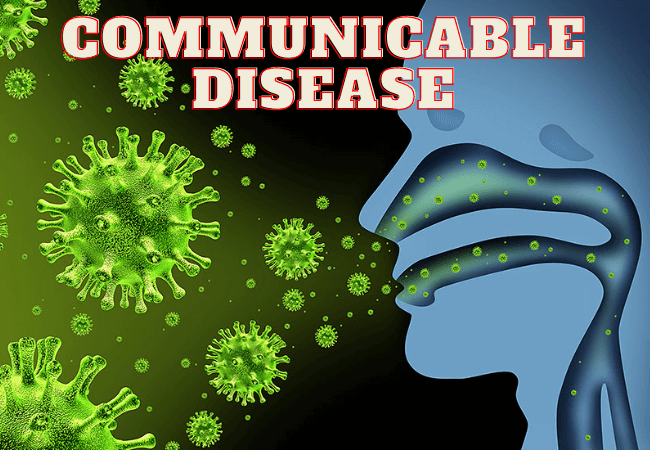Mode of Transmission and Types of Communicable Disease
Definition of Communicable Disease:
An illness due to a specific infectious agent or its toxic product capable of being directly or indirectly transmitted from man to man, man to animal, animal to man, animal to animal or from environment (through air, dust, soil, water, food etc.) to man or animal.

Classification or Types of Communicable Disease:
Bacterial diseases | Diphtheria, enteric fever ,whooping cough,plague, anthrax |
Viral diseases | Poliomyelitis, viral hepatitis, influenza, bird flu etc. |
Protozoal diseases | Amoebiasis, giardiasis, trichomoniasis, malaria etc. |
Helminthic diseases | Ascariasis, ancylostomiasis, filariasis, taeniasis etc. |
Sexual transmitted diseases | Syphilis, gonorrhea, AIDS etc. |
Zoonotic diseases | Rabies, brucellosis, hydatid disease etc. |
Arthropod borne diseases | Dengue, malaria, kala-azar etc. |
Others | ARI, SARS, Food poisoning |
Or | |
Respiratory infection | Small pox, chickenpox, Measles, Mumps, Rubella, Influenza, Diphtheria, Whooping cough, Meningococcal meningitis, ARI, SARS, TB. |
Intestinal infection | Poliomyelitis, viral hepatitis, cholera, Acute diarrheal diseases, typhoid fever, Food poisoning, Ameobeasis, Ascariasis, Hookworm infection. |
Arthropod borne disease | The dengue syndrome malaria, lympathic filariasis |
Zoonosis | Rabies, Yellow fever, Brucellosis, plague, Human salmenolosis, Ricketsial diseas, Taeniasis, Hydatid disease, Leismeniasis. |
Surface infection | Trachoma, tetanus, Leprosy, STD, Endemic treponomatosis, AIDS. |
Mode of Transmission of Communicable Disease:
1. Direct transmission or contact:
- Direct contact: Touching an infected person by any means, including Sexual contact. eg. Leprosy, many skin and eye infections, STD (sexual transmitted disease) and AlDS.
- Dropiet Intection:- Disease transmission by saliva and nasopharyngeal secretions through coughing or sneezing, speaking and spitting into the atmosphere. eg. Tuberculosis (TB), Diphtheria, Pertussis, and many other respiratory infections.
- Contact with soil. eg. Hookworm larvae, Tetanus, mycosis,
- Trans-placental:- AIDS, Hepatitis B, Syphilis, etc.
- Skin or mucous membrane: – eg, Rabies viruses by dog bite, HBV.
2. Indirect transmission or contact: It occurs by touching any object or surface. It encompasses the 5 “F’s these are flies, finger, fomites, food and fluid.
- Vehicle borne: – Water, food, ice, blood, serum, plasma and other biological product. eg
- Vector borne: – Biological, Mechanical.
- Airborne transmission: -If the microorganism remain in the air for long periods as droplet nuclei and dust.
- Fomite borne: – Soiled clothes, towels, linen, handkerchiefs, cups, spoons, pencils, books, toys, door, handles, drinking glasses, tap, syringes, instruments and surgical dressings.
- Unclean hands and fingers.
Communicable Disease in Children:
It includes the following:
- Measles,
- Malaria,
- Tetanus,
- Diphtheria,
- Pertussis,
- Scabies,
- Chickenpox,
- Viral hepatitis,
- Influenza,
- Mumps,
- Poliomyelitis,
- Diarrhoeal diseases,
- Leprosy,
- HIV/AIDS,
- Dengue syndrome.
Non-Communicable Disease in Children:
It includes the following:
- Cardiovascular diseases,
- Blindness,
- Coronary heart disease,
- Cancer,
- Rheumatic heart disease,
- Hypertension,
- Diabetes,
- Stroke,
- Obesity,
- Accident and injuries.
More questions related to this article:
- Define communicable diseases
- What do you mean by communicable diseases?
- What is meant by communicable diseases?
- Classify the modes of transmission of communicable disease with one example of each.
- Explain disease transmission.
- Classify communicable diseases.
- What are the different types of communicable diseases?
- Name the common communicable & Non-communicable disease in children?

Maria Khatun Mona is a Founder and Editor of Nursing Exercise Blog. She is a Nursing and Midwifery Expert. Currently she is working as a Registered Nurse at Evercare Hospital, Dhaka, Bangladesh. She has great passion in writing different articles on Nursing and Midwifery. Mail her at “maria.mona023@gmail.com”
